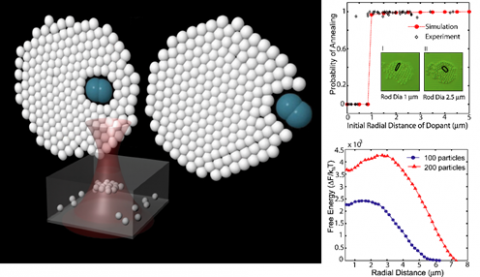
Using a modified and highly configurable optical trap we have observed formation of 2D colloidal crystallites whose phase and sizes can be controlled. This system allows us to study the dynamics of foreign dopants injected into the crystallites. The striking result obtained here was the ability of finite-sized colloidal clusters to expel or internalize a foreign dopant depending on its initial position. The internal energy of the system was found to decrease as the dopant gets expelled, which by itself would imply expulsion of the dopant, whereas decrease in entropy due to order formation as dopant is expelled favours internalization. Observations show that the rate of change of the entropy with increasing distance of the dopant from the centre is higher than that of the internal energy up to a certain radial distance of the dopant, after which the rate of change in the entropy is lower. This gives rise to a free energy barrier which leads to internalization of the dopant when it is within a certain radial distance and its expulsion when it is outside this region.
Figure 1: Schematic of the confined colloidal crystal with a dopant inside. The top plot shows the probability of expulsion of dopants wrt to radial distance. The bottom plot shows the corresponding free energy barrier which causes internalization and expulsion
References: Role of Entropy in the Expulsion of Dopants from Optically Trapped Colloidal Assemblies -Physical Review Letters, PRL 117, 258002 (2016)
